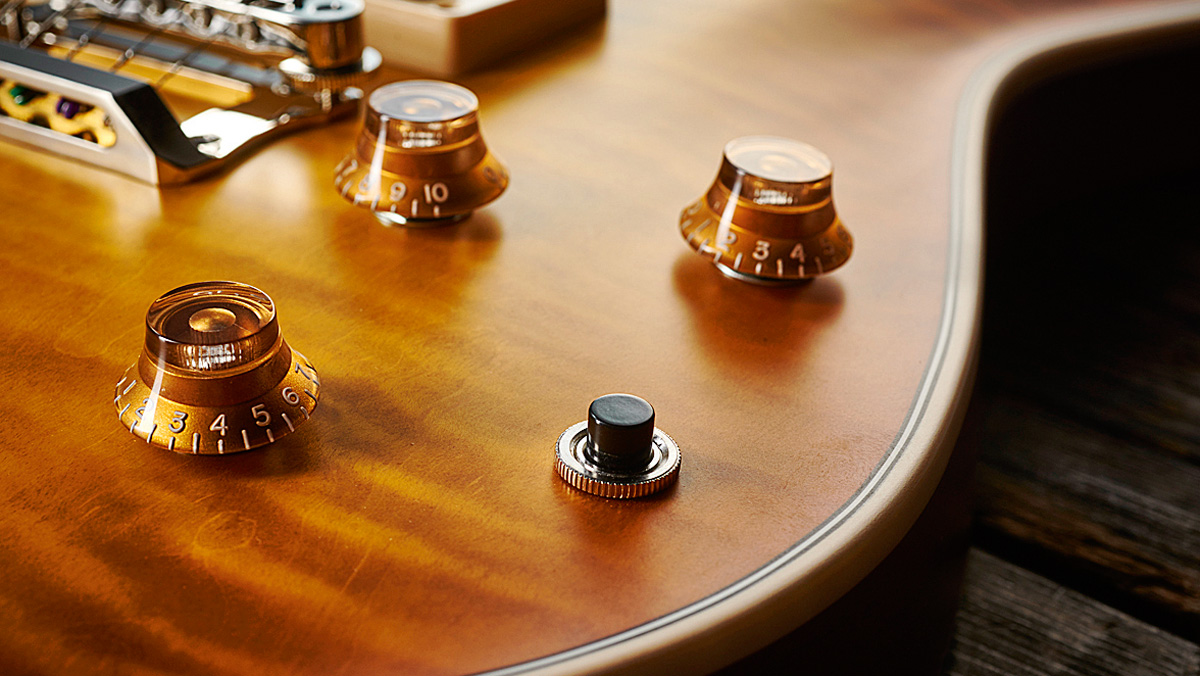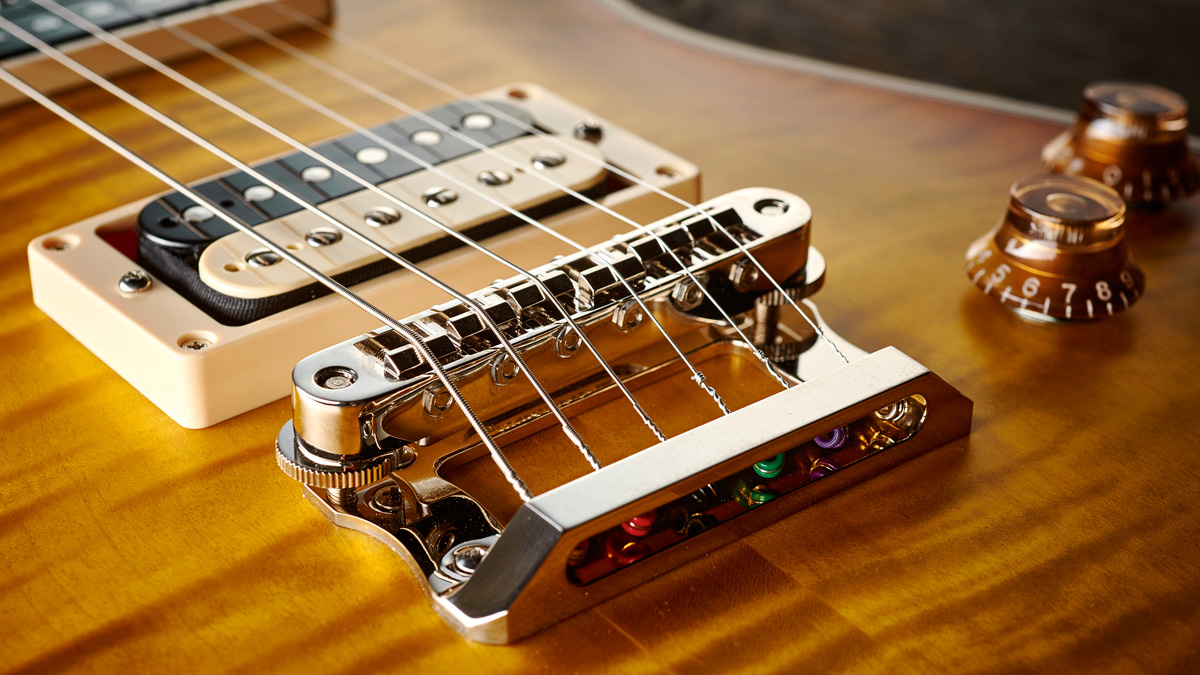MusicRadar Verdict
It’s not cheap, but not only would we strongly suggest you try one, we’d simply say, start saving.
Pros
- +
Top-drawer design and build.
- +
Muscular single-cut tonality and workingman’s vibe.
Cons
- -
The non-LP looks won’t appeal to everyone.
MusicRadar's got your back
While many makers obsess about the replication of vintage ’Bursts, Joe Knaggs isn’t one of them.
As this signature Kenai illustrates, it’s obvious where the inspiration lies. It’s the second Knaggs artist model, after Steve Stevens’, and regular Guitarist readers should be very familiar with the skills of Doug Rappoport who joined us for a blues-rock masterclass earlier this year.
Steve’s signature model slightly downsizes the Kenai blueprint, but here Doug’s uses the original plans with its almost Tele-meets-Les Paul outline measuring approximately 344mm (13.54 inches) across its lower bouts, with a trimmer-than-LP maximum depth of 52mm.
It appears even trimmer (and is tapered from base to heel) when you look at the rim: while the top has a beautifully graduated carve, the back is flat with a rib-cage cutaway and noticeable chamfering around the edges, reducing that rim to approximately 43mm. Neither chambered nor weight-relived, this Kenai weighs a near perfect 8.5lbs.
“Very much pain goes into finding the right weight wood,” considers Joe from Knaggs HQ in Greensboro, Maryland. “It is getting more and more difficult. I’m not sure if weight relief or chambering is the future: there are other woods out there that are lighter in weight. I do think harder/heavier woods tend to be a bit more dominant on the treble side, but this is not always the case. I’ve heard great-sounding heavier guitars. I’ve heard crappy-sounding light guitars, too – not ours, I might add!”

On first playing a Kenai, weight played its part for Doug. “I was struck by how light it was,” he tells us. “I realise weight - where guitars are concerned - is unpredictable and varies widely. I am also aware there is a lot of debate about wood density, weight and what it means to tone. Fuck all that. I tell people to go tour for 15 to 20 years and then tell me how important having a heavy guitar is to you!”
Following the classic Gibson-style ingredients, the mahogany back here is one piece, likewise the neck. The Tier 3 maple top has quite thick cream-coloured edge binding and an inner black/white/black purfling, plus quite a classic but not overdone figure toned down here by the satin nitro finish.
The neck is raked back in classic style, and while the unbound headstock has a lesser back-angle, it still looks very old-school with that classy understated logo on a black ebony facing with Doug’s signature truss rod cover.
Fret wire is medium gauge, immaculately installed as you’d expect, on the Gibson-like 305mm (12-inch) cambered, bound Macassar ebony ’board. We’ve said it before and have to say it again: Knaggs makes exceptionally good guitars.
If you’re looking for flaws, good luck. The dual-humbucker layout with its shoulder-mounted pickup selector is par for the course, though where we’d usually find a bridge pickup tone control there is a momentary action kill switch (you can order it with a standard tone control if you prefer).

The double-black ’bucker at the neck is Duncan’s classic SH-2N Jazz (described as a “bright, vintage-output humbucker, which stays clear even under extreme distortion”); the bridge is a lesser-known Duncan Custom Shop pickup, a zebra-coiled ’78.
“As an EVH fanatic/devotee/disciple/worshipper, I had to have one,” enthuses Doug. “Honestly, it was more the concept of the pickup that interested me - a clone of the pickup Seymour rewound for EVH back in 1978. A PAF supposedly from an old ES-335. I was a Duncan JB player for years!
“I’m really savvy with that pickup,” he continues. “When I got my first Knaggs, it came with a much lower-output ’59. My intention was to immediately swap it for my usual JB, but I was enjoying it so much with the ’59: clarity, open sounding… all the usual benefits of lower-output pickups. So now I’m in love with PAF-type pickups.
“The thing I liked about the ’78 was that it was basically a great PAF with a little more output. I had found that the lack of output in the ’59, and other PAF-type pickups, to be a little too gentle - not pushing the amps hard enough for me. My range as a player goes from straight-ahead blues all the way through classic rock, hard rock through heavy metal.
“The ’78, as a low-medium output pickup, lets me comfortably cover all that on guitar. And it does a fantastic Van Halen! So if you can forget that it’s a EVH pickup, you’ll just have a high-quality PAF with just a little more ‘poop’ on it. Very versatile.”
Feel & Sounds
There’s an elegant simplicity to this guitar that belies the craft. The guitar disappears: its good weight, the full rounded depth of the neck, the classic, relatively small fret wire, the resonance, a full, luscious acoustic ring and sustain, the switch and control placement…
It feels like a guitar you’ve played all your life, a road-buddy that’s never let you down. Warming up our test rig with our ’57 Les Paul Junior, we’re reminded of the Kenai’s heritage, not least its big rounded neck profile, although the DR slightly expands it (and it’s fractionally bigger in the higher positions than an older Knaggs we have with its ’59 profile).
Whatever, it feels like a big neck and like the sounds it helps to produce… well, ‘meaty’ springs to mind. Continuing with a 2017 Les Paul Standard, we’re bang up to date in terms of single-cut tone, but plug in the Knaggs and we’re treated to a single-cut voice that’s hugely organic, more muscular with a clarity combined with a thumpingly huge-sounding, resonant midrange grind and fat low-end. It simply sounds huge. Did we say that already?
But it’s far from a one-trick pony. Pull back the volumes and the Jazz creates a surprisingly rootsy Americana voice that - mixed with the ’78 - is springy, expressive and almost single coil-like. While it excels at Doug’s signature AC/DC/Van Halen crunch, rolling the volume back also summons up plenty of single-cut greats: cleaner Peter Green through Mick Ronson’s Spiders-era edgy rhythm and plenty more besides.
It’s a guitar that allows you to suggest styles, not the other way around. Like we said, it feels and sounds like a guitar we’ve had for years. The truth is, with time and playing, it’ll only get better.
We’re constantly criticised for writing about elitist high-end instruments, and while sometimes it is very difficult to justify an instrument’s cost, that’s not the case here. Elsewhere in this issue we look at lower-cost single-cuts that are perfectly valid, yet none of those capture the muscular power of this one on full tilt.
Kill switch aside (and that’s optional), there are no bells or whistles: its calling card is the vast experience of its maker, married with intelligent twists such as the body’s geometry, that unique bridge design, its top-drawer materials all presented - by design - in this workingman’s blue collar vibe.
Dave Burrluck is one of the world’s most experienced guitar journalists, who started writing back in the '80s for International Musician and Recording World, co-founded The Guitar Magazine and has been the Gear Reviews Editor of Guitarist magazine for the past two decades. Along the way, Dave has been the sole author of The PRS Guitar Book and The Player's Guide to Guitar Maintenance as well as contributing to numerous other books on the electric guitar. Dave is an active gigging and recording musician and still finds time to make, repair and mod guitars, not least for Guitarist’s The Mod Squad.
“We were arguing a lot and we were miserable”: How Green Day exceeded expectations with their most ambitious song
"There’s plenty for us guitarists to learn – and ‘less is more’ is the overriding lesson": how to play like George Harrison on The Beatles' Abbey Road
“They didn’t like Prince’s bikini underwear”: Prince’s support sets for the The Rolling Stones in 1981 are remembered as disastrous, but guitarist Dez Dickerson says that the the crowd reaction wasn’t as bad as people think











